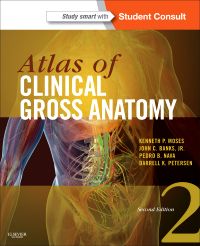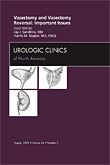Vasectomy and Vasectomy Reversal: Important Issues, An Issue of Urologic Clinics, 1st Edition
Authors :
Jay I. Sandlow & Harris M. Nagler
In spite of the fact that vasectomy is currently the most commonly utilized form of male contraception and it has been in use for more than 50 years, very little has been written regarding standards of practice, procedure, and follow up. This issue
...view more
In spite of the fact that vasectomy is currently the most commonly utilized form of male contraception and it has been in use for more than 50 years, very little has been written regarding standards of practice, procedure, and follow up. This issue addresses these issues in such a way to allow the reader to evaluate what works best for their individual practice utilizing evidence-based medicine when it exists. It is not surprising in a society with a divorce rate of aproximately 50 % and an excess of 500,000 vasectomies per annum, that there is demand for vasectomy reversal. Approximately 6% of vasectomies are reversed. Although the most common indication for vasectomy reversal is remarriage, there are other indications. This issue addresses issues that are of concern when reversal is discussed with the patient seeking to restore his fertility.
Your discount code here : #FB456
In spite of the fact that vasectomy is currently the most commonly utilized form of male contraception and it has been in use for more than 50 years, very little has been written regarding standards of practice, procedure, and follow up. This issue addresses these issues in such a way to allow the reader to evaluate what works best for their individual practice utilizing evidence-based medicine when it exists. It is not surprising in a society with a divorce rate of aproximately 50 % and an excess of 500,000 vasectomies per annum, that there is demand for vasectomy reversal. Approximately 6% of vasectomies are reversed. Although the most common indication for vasectomy reversal is remarriage, there are other indications. This issue addresses issues that are of concern when reversal is discussed with the patient seeking to restore his fertility.
Author Information
By Jay I. Sandlow, MD and Harris M. Nagler, MD, FACS
| ISBN Number | 9781437712780 |
|---|---|
| Main Author | By Jay I. Sandlow, MD and Harris M. Nagler, MD, FACS |
| Copyright Year | 2009 |
| Edition Number | 1 |
| Format | Book |
| Trim | Other |
| Imprint | Saunders |
| Page Count | 0 |
| Publication Date | 20 Aug 2009 |
| Stock Status | IN STOCK - This may take up to 5 business days to ship |
Write Your Own Review
Only registered users can write reviews. Please sign in or create an account
product
https://www.us.elsevierhealth.com/vasectomy-and-vasectomy-reversal-important-issues-an-issue-of-urologic-clinics-9781437712780.html
6132
Vasectomy and Vasectomy Reversal: Important Issues, An Issue of Urologic Clinics
https://www.us.elsevierhealth.com/media/catalog/product/9/7/9781437712780.jpg
69.29
98.99
USD
InStock
/Medicine/Urology
/Clinics
/Clinics
128
4388725
5255041
1
3
8
4182692
5145120
In spite of the fact that vasectomy is currently the most commonly utilized form of male contraception and it has been in use for more than 50 years, very little has been written regarding standards of practice, procedure, and follow up. This issue addresses these issues in such a way to allow the reader to evaluate what works best for their individual practice utilizing evidence-based medicine when it exists. It is not surprising in a society with a divorce rate of aproximately 50 % and an excess of 500,000 vasectomies per annum, that there is demand for vasectomy reversal. Approximately 6% of vasectomies are reversed. Although the most common indication for vasectomy reversal is remarriage, there are other indications. This issue addresses issues that are of concern when reversal is discussed with the patient seeking to restore his fertility. In spite of the fact that vasectomy is currently the most commonly utilized form of male contraception and it has been in use for more than 50 years, very little has been written regarding standards of practice, procedure, and follow up. This issue addresses these issues in such a way to allow the reader to evaluate what works best for their individual practice utilizing evidence-based medicine when it exists. It is not surprising in a society with a divorce rate of aproximately 50 % and an excess of 500,000 vasectomies per annum, that there is demand for vasectomy reversal. Approximately 6% of vasectomies are reversed. Although the most common indication for vasectomy reversal is remarriage, there are other indications. This issue addresses issues that are of concern when reversal is discussed with the patient seeking to restore his fertility.
0
0
add-to-cart
9781437712780
2011 and earlier
Professional
By Jay I. Sandlow, MD and Harris M. Nagler, MD, FACS
2009
1
Book
Other
Saunders
0
Aug 20, 2009
IN STOCK - This may take up to 5 business days to ship
By <STRONG>Jay I. Sandlow</STRONG>, MD and <STRONG>Harris M. Nagler</STRONG>, MD, FACS
Clinics
Clinics
The Clinics: Internal Medicine
No
No
No
No
Please Select
Please Select
Please Select
Related Products
-
35% OFF
 Flash Cards
Flash Cards
-
35% OFF
 Book
Book
-
35% OFF
 Flash Cards
Flash Cards
-
30% OFF
 Book
Book
-
35% OFF
 Book
Book
-
35% OFF
 Book
Book
-
35% OFF
 Flash Cards
Flash Cards
-
30% OFF
 Book
Nolte's The Human Brain in Photographs and Diagrams
Book
Nolte's The Human Brain in Photographs and DiagramsTodd W. Vanderah
Jan 2019
Special Price $44.79 $63.99 -
35% OFF
 Book
Book
-
35% OFF
 Online Resource
Netter's Dissection Video Modules (Retail Access Card)
Online Resource
Netter's Dissection Video Modules (Retail Access Card)University of North Carolina Chapel Hill and Frank H. Netter
Oct 2015
Special Price $117.64 $180.99




